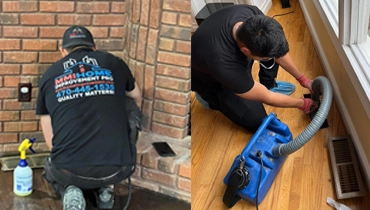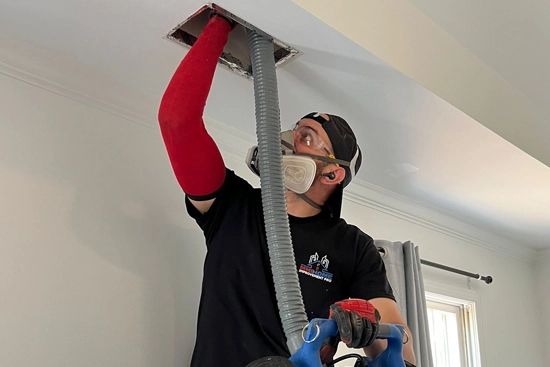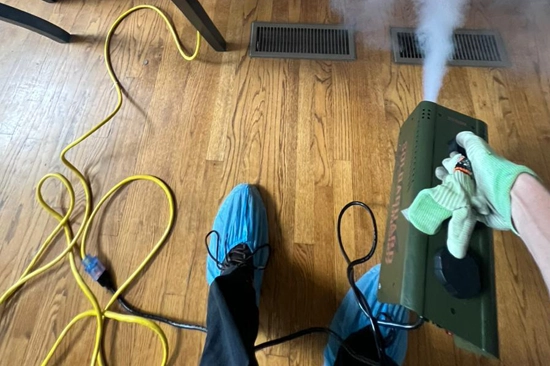Mold can thrive in dark, damp areas behind walls, posing risks to your home and health. Knowing how to detect and safely remove mold is necessary to prevent potential damage and respiratory issues. In this guide, we will walk you through the signs of hidden mold, the best ways to detect it, and steps for safe removal. Let’s begin the journey to create a healthier living space.
Methods to Safely Remove Mold Hidden Behind Walls
Mold hidden behind walls can cause health risks and can cause damage to your home. Transform your home with MMI Home Improvement’s expert services. Are you living in Duluth? Call us for Mold Air Duct Cleaning in Duluth for a cleaner, healthier space. Safely removing mold from behind walls requires a careful approach. Start by using protective gear and contain the affected area. Use proper cleaning methods to remove the mold effectively.

Choosing Appropriate Protective Gear and Equipment
You need protective gear to stay safe when dealing with mold. Start with a face mask rated for mold spores to prevent breathing them in. Wear gloves to protect your hands when handling cleaning solutions or touching moldy surfaces. Cover your body with disposable overalls to keep your clothing clean. Also, wear safety goggles to protect your eyes.
Choose the right equipment for mold removal. A vacuum cleaner with a HEPA filter can safely remove loose mold spores. Use a good disinfectant or mold-killing solution to clean the area. Keep a scrub brush handy for cleaning moldy surfaces effectively.


Containing the Affected Area to Prevent Mold Spread
Preventing mold from spreading during the removal process is very important. Seal off the area using plastic sheeting or barriers to contain the mold. This helps stop mold spores from traveling to other parts of your home.
Secure the plastic sheeting tightly around doorways and vents with duct tape. This helps keep the mold spores contained within the work area. Place an air scrubber or a machine that creates negative air pressure inside the contained area to filter mold spores and reduce the risk of airborne contamination.
Implementing Proper Cleaning Techniques to Remove Mold
Use proper cleaning methods to remove mold and stop it from coming back. Begin by taking out any damaged materials, such as drywall or insulation. Carefully dispose of these materials in sealed plastic bags to prevent the spreading of mold spores.
Scrub the hard surfaces with a mold-killing solution. Let the solution sit for the recommended time to clean the surface thoroughly. Afterward, use a brush to scrub away mold and thoroughly rinse the surface.
You may need to replace the affected materials for solid surfaces like wood or plaster. Mold can go deep into these surfaces, making it hard to remove them. If replacement is not possible, use a special mold remover.
After cleaning:
- Dry the area thoroughly to prevent mold from returning.
- Use fans or dehumidifiers to speed up the drying process.
- Ensure the space is properly ventilated to reduce moisture buildup, which can cause mold growth.
Aftercare and Prevention
After removing mold:
- Keep an eye on the affected area.
- Watch for signs of mold regrowth, such as discoloration or a musty smell.
- Address any new issues quickly to prevent further damage.
Prevention is key to avoiding future mold problems. Fix any leaks or water damage in your home as soon as possible. Maintain proper ventilation and humidity control to keep moisture levels low. Regularly inspect your home for signs of mold and deal with any issues promptly.
Following these practices will help you keep a safe and healthy home environment.
Learn how to Say Goodbye to Mold with Our Air Duct Cleaning Services.
Preventing Future Mold Growth After you remove mold
After getting rid of mold, it’s important to stop it from returning. You can do this by ensuring things are dry, fixing problems that cause mold, and keeping an eye on where mold might grow again.
Making Things Dry and Less Humid
To stop mold from coming back, make sure everything is dry. Use machines that take moisture out of the air, called dehumidifiers. This helps get rid of wetness, which is what mold needs to grow.
Use fans and open windows to help air move around and things dry faster. Look in hidden spots like behind walls and under floors. Good airflow can help stop mold from growing again.
After everything is dry, use dehumidifiers to check how much moisture is in the air. It’s best to have between 30% and 50% humidity inside. Keeping things dry like this can stop mold from growing again.
Fixing Problems That Cause Mold
Next, find and fix why mold grew in the first place. If you don’t fix these problems, mold might come back. For example, if pipes are leaking or there’s not enough air moving around, you must fix that.
Check places where water might be getting in, like bathrooms and basements. Look for leaks in roofs and windows. Seal any cracks in walls and floors to prevent water from getting in.
Keep things like air conditioners and dryers in good shape. Clean them often so water doesn’t build up and cause mold. Fixing these problems will help keep mold away.
Watching Out and Keeping Things Clean
Keep an eye on places where mold might grow again. After you’ve fixed the mold and other problems, check to ensure they don’t come back. This helps you stop mold before it gets bad again.
Look in places that get wet a lot, like bathrooms and basements. Check if there’s water on windows and walls. If you see water, dry it up quickly to prevent mold from returning.
You can get machines that tell you how much moisture is in the air. You can use dehumidifiers to dry things out if it’s too humid. Keeping an eye on things like this helps you stop mold from growing again.
By doing this, you can keep your house safe and healthy.
